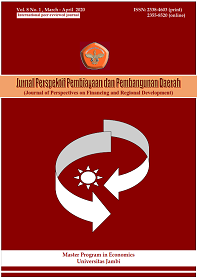Hedonic value motivation: impact on consumers’ purchase intention
DOI:
https://doi.org/10.22437/ppd.v8i1.7468Keywords:
Fashion involvement, Hedonic value, Outlet atmosphere, Purchase intention, Retail servicesAbstract
The focus of this study, using an explanatory and accidental approach, shows consumer buying interest in shopping at modern shopping centers in Surabaya. Data were collected from 90 questionnaires and analysed using the Partial Least Square (PLS). The results of the study showed that consumer buying interest at the modern shopping centers (malls) was driven by hedonic impulses. It is evident from the positive significance value associated with consumer perceptions of the atmosphere of the outlet, of retail services, as well as the presence of fashion that contains hedonist value so as to have an effect on consumers’ purchase intentions. For future studies, it is best to examine utilitarian aspects as a motivation that affects the purchasing intention of consumers at modern shopping centers
Downloads
References
Abednego, F. (2011). Analisis Pengaruh Atmosfer Gerai Terhadap Penciptaan Emosi (Arousal dan Pleasure), Perilaku Belanja (Motivasi Belanja Hedonik dan Motivasi belanja Utilitarian), dan Terhadap Pendekatan Perilaku. Fokus Ekonomi, 10(2), 125-139.
Asrini, A. & Musnaini, M.. (2019). Meningkatkan Motivasi Konsumen Membeli Produk Lokal Di Kota Jambi. Prospek: Jurnal Manajemen dan Bisnis, 1(1), 16 - 23
Babin, B. J., Darden, W. R. & Griffin, M. (1994). Work and/or fun: measuring hedonic and utilitarian shopping value. Journal of Consumer Research, 20(4), 644–656. https://doi.org/10.1086/209376
Cottet, P., Lichtlé, M.C. & Plichon, V. (2006). The role of value in services: a study in a retail environment. Journal of Consumer Marketing, 23(4), 219-227 https://doi.org/10.1108/07363760610674347
Fam, K.S., Merrilees, B., Richard, J. E. & Jozsa, L. (2011). In-store marketing: a strategic perspective. Asia Pacific Journal of Marketing and Logistics, 23(2), 165-176
Ghozali, I. (2008). Model Persamaan Struktural Konsep dan Aplikasi dengan program AMOS 16.0. Semarang: Badan Penerbit Universitas Diponegoro
Handayani, W, Anshori, M., Usman, I. & Mudjanarko, S. (2018). Why are you happy with impulse buying? Evidence from Indonesia. Management Science Letters, 8(5), 283–292. https://doi.org/10.5267/j.msl.2018.4.019
Handayani, Wiwik, Iryanti, E. & Hardjati, S. (2019). The Distinction of Impulse Buying Behavior in Traditional Markets. Opcion, 35(20), 144–163.
Hausman, A. (2000). A multi-method investigation of consumer motivations in impulse buying behavior. Journal of Consumer Marketing, 17(5), 403–426. https://doi.org/10.1108/07363760010341045
Japarianto, E. & Sugiharto, S. (2011). Pengaruh Shopping Life Style Dan Fashion Involvement Terhadap Impulse Buying Behavior Masyarakat High Income Surabaya. Jurnal Manajemen Pemasaran, 6(1), 1-24. https://doi.org/10.9744/pemasaran.6.1.32-41
Kang, J. & ParkPoaps, H. (2010). Hedonic and utilitarian shopping motivations of fashion leadership. Journal of Fashion Marketing and Management: An International Journal. https://doi.org/10.1108/13612021011046138
Lin, Z. J. & Zhang, J. (2011). Ethical awareness of Chinese business managers and accountants and their views on the use of off-book accounts. Advances in Accounting, 27(1), 143–155. https://doi.org/10.1016/j.adiac.2011.04.004
Marianty, R. & Junaedi, M.F.S. (2014). Pengaruh keterlibatan fashion, emosi positif, dan kecenderungan konsumsi hedonic terhadap pembelian impulsif. Jurnal Magister Manajemen, 1–15.
Musnaini, M., Astuti, S., Sukoco, B., & Yacob, S. (2017). Effect Of Hedonic Value And Consumer Knowledge On Buying Intention For Luxury Brand Counterfeit Products. International Journal of Busines Globalisation, 19(4), 497-511. DOI: https://doi.org/10.1504/Ijbg.2017.10007899
Ratnasari, K. & Yulianti, I. (2016). Pengaruh Hedonic Value Dan Consumer Expertise Terhadap Keputusan Pembelian Smartphone (Studi Pada Pengguna iPhone 5S Di Kota Malang). Jurnal Ilmiah Mahasiswa FEB Universitas Brawijaya, 3(2).
Rintamäki, T., Kanto, A., Kuusela, H. & Spence, M. T. (2006). Decomposing the value of department store shopping into utilitarian, hedonic and social dimensions. International Journal of Retail & Distribution Management, 34(1), 6 - 24. DOI: https://doi.org/10.1108/09590550610642792
Scarpi, D. (2006). Fashion stores between fun and usefulness. Journal of Fashion Marketing and Management, 10(1), 7-24. DOI: https://doi.org/10.1108/13612020610651097
Semuel, H. (2005). Respons Lingkungan Berbelanja Sebagai Stimulus Pembelian Tidak Terencana Pada Toko Serba Ada (Toserba) (Studi Kasus Carrefour Surabaya). Jurnal Manajemen Dan Kewirausahaan, 7(2), 101–115.
Yistiani, N.N.M., Yasa, N.N.K. & Suasana, I.G.A.K.G. (2012). Pengaruh Atmosfer Gerai Dan Pelayanan Ritel terhadap Nilai Hedonik Dan Pembelian Impulsif pelanggan Matahari Department store Duta Plaza di Denpasar. Jurnal Manajemen, Strategi Bisnis Dan Kewirausahaan, 6(2), 139-149
Zang, Y., Combs, H. W., & Chaipoopirutana, S. (2011). The Influence of the Mall Environment on Shoppers’ Values and Consumer Behavior in China. Proceedings of American Society of Business and Behavioral Sciences Conference, 18(1), 214-224
Downloads
Published
How to Cite
Issue
Section
License
Copyright (c) 2020 Wiwik Handayani, Musnaini Musnaini, Wahyudan Iswara Praditya

This work is licensed under a Creative Commons Attribution 4.0 International License.

















